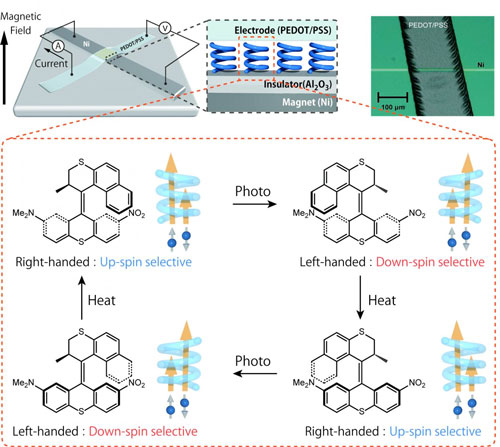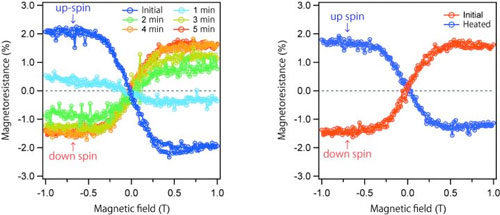| Jun 07, 2019 | |
Manipulating electron spin using artificial molecular motors(Nanowerk News) In spintronics, the use of organic materials as a "spin transport material" has recently garnered significant attention as they exhibit long spin-relaxation times and long spin-diffusion lengths owing to the weak spin-orbit interaction (SOI) of light elements. Meanwhile, the weak SOI of organic materials become a drawback when they are used as a "spin filter". A spin-polarized current is, therefore, typically generated by inorganic materials with ferromagnetism or strong SOIs. |
|
| However, the recent finding of spin-selective electron transport through chiral molecules, i.e., the so-called chirality-induced spin selectivity (CISS) effect, suggests an alternative method of using organic materials as spin filters for spintronics applications. Through this effect, right-handed and left-handed molecules generate down- and up-spin, respectively. | |
| However, chiral molecules used in the experiments reported so far are static molecules. Hence, the manipulation of spin-polarization direction by external stimuli has not been realized yet. | |
| Now, researchers at Institute for Molecular Science, RIKEN, Nara Institute of Science and Technology, Suranaree University and Vidyasirimedhi Institute of Science and Technology fabricated a novel solid-state spin filtering device that sandwiches a thin layer of artificial molecular motors (Figure 1). | |
 |
|
| Figure 1: Unidirectional rotation of the artificial molecular motor. Blue helices represent the artificial molecular motors. The rotation cycle of the artificial molecular motor includes 4 times chirality inversion, resulting in 4 times switching of the spin-polarization direction of currents. (Image: NINS/IMS) (click on image to enlarge) | |
| Because the artificial molecular motors demonstrate 4 times chirality inversion by light irradiation and thermal treatments during the 360-degree molecular rotation, the spin-polarization direction of electrons that pass through the molecular motors should be switched by light irradiation or thermal treatments. | |
| Figure 2 shows (left) the magnetoresistance (MR) curves recorded after various visible light-irradiation time for a device fabricated with a left-handed isomer. In the initial state, a clear antisymmetric MR curve with a negative slope was observed, which means a clear up-spin selectivity. The MR signal decreased as light irradiation proceeded, and finally the slope of the MR signal was inverted to positive, indicating a light-induced spin switching in the spin-polarized current from up-spin selective to down-spin through the left-handed-to-right-handed chirality inversion. | |
| A subsequent thermal activation process for the left-handed isomer inverted the slope of the MR curve from positive to negative again, as shown in Figure 2 (right), implying a thermal-activation-induced spin switching from down-spin selective to up-spin selective through the right-handed-to-left-handed chirality inversion. Similar phenomena were observed in subsequent measurements after photo-irradiation and thermal treatments. | |
 |
|
| Figure 2: (Left) MR curves recorded after various visible light-irradiation time for a device fabricated with a left-handed isomer. (Right) MR curves recorded before and after the thermal treatment for a device with a right-handed isomer. (Image: NINS/IMS) (click on image to enlarge) | |
| This series of experiments clearly demonstrated that 4 times spin switching were induced during the 360-degree rotation of the molecular motors (Nature Communications, "Light-driven molecular switch for reconfigurable spin filters"). | |
| In this new type of novel organic spintronics device, the right-handed/left-handed chirality, which is the origin of spin-polarization generation through the CISS effect, is reconfigurable by external stimuli and precise control of the spin-polarization direction in the spin-polarized currents by utilizing an artificial molecular motor was realized, for the first time. The present results are beneficial for the development of next-generation organic photo/thermospintronic devices combined with molecular machines. |
| Source: National Institutes of Natural Sciences | |
|
Subscribe to a free copy of one of our daily Nanowerk Newsletter Email Digests with a compilation of all of the day's news. |
